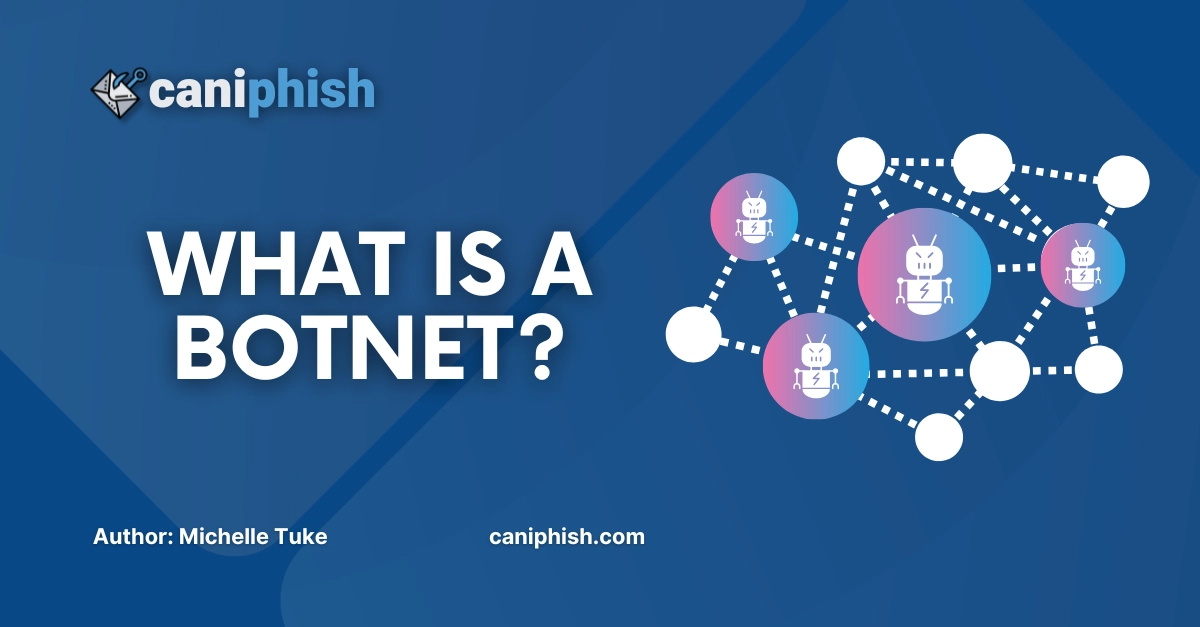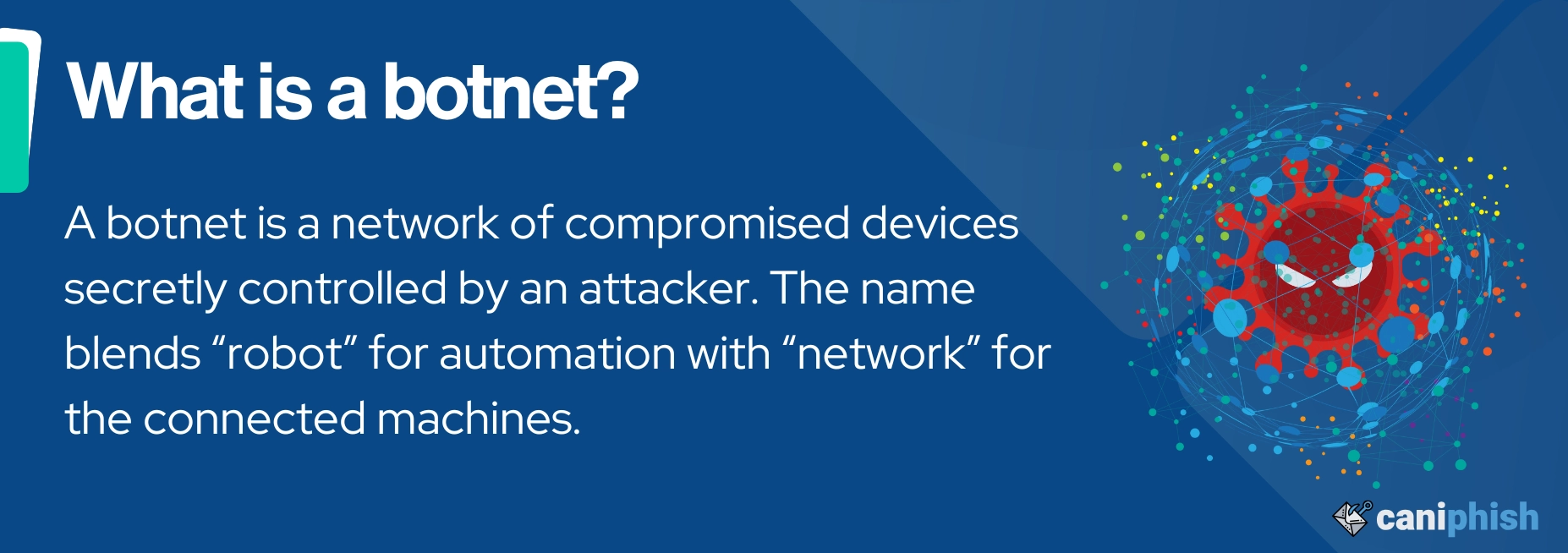What Is A Botnet?

A botnet is a collection of compromised computers or devices that are linked together and controlled by an attacker to perform malicious tasks, without the users’ knowledge.
The term "botnet" is a blending of the words "robot" and "network."

Why Are Botnets Dangerous?
Botnets are dangerous because they turn everyday devices into silent, anonymous cyber weapons. Here are some of the key dangers in more detail:
Large-Scale Attacks
An attacker can control thousands or even millions of infected devices at once. This network of botnets can launch Distributed Denial of Service (DDoS) attacks to crash websites, flood inboxes with spam, or overload login pages with stolen credentials until something cracks.
Anonymity
Botnets are hard to trace because the attacker doesn’t launch attacks directly, they hide behind a swarm of compromised devices scattered across the world. Each infected device (or bot) acts as a middleman, masking the origin. Even if one bot is discovered, it’s just a tiny piece of a much bigger puzzle.
Versatility
Botnets can serve multiple purposes. Attackers can rent them out, modify their behaviour on the fly or repurpose them for different campaigns. The same botnet that was used to send spam can later be used in a DDoS attack.
Silent And Stealthy
Most people have no idea their device has been silently hijacked and used to conduct botnet attacks. There’s no red alert. No flashing warning. Just a quiet infection running in the background.
Cost-Effective
The attacker doesn’t pay for internet, power, or hardware. That burden falls on the unsuspecting owners of devices that have been compromised. All the attacker has to do is issue commands from a Command & Control (C2) server, and the botnet takes care of the rest.
IoT And Mobile Devices
Botnets aren’t limited to computers anymore. Internet of Things (IoT) devices, like smart TVs, security cameras, and even smart speakers, are now prime targets. This significantly broadens the number of potential devices that are ripe for takeover and incorporation into a botnet.
How Do Botnets Work?
Botnets follow a predictable process. They start with one infected device, then spread to others until the attacker controls a network of compromised devices. Here’s how it happens:
-
Initial Infection
The attacker starts by hunting for a vulnerability. Maybe a flaw in software, an outdated app, a poorly secured website, or human error. Once they’ve found a way in, they silently install malware on the device.
-
Remote Control Setup
Once the malware is installed, the device connects to the attackers C2 server. The attacker now has full control of the device turning it into a bot. It can now download more malware, receive commands, and even recruit new bots
Botnet Expansion
The infected device spreads the malware, recruiting more bots to scan for vulnerabilities, send phishing emails, or exploit software flaws.
Stealth Mode
The botnet blends in and plays the long game now. The malware often disguises itself as legitimate software or hides in system files, waiting to be activated.
Execution of Commands
Once the attacker has infected enough devices, they can begin issuing commands and put the botnet to work.
Updates & Persistence
Botnets can stay undetected because they're constantly evolving. Malware can receive updates from its controller, adapting to avoid detection, changing tactics, or adding new capabilities. In some cases, botnet masters will even patch vulnerabilities on the devices they compromise to prevent other attackers from taking over devices in their botnet!
Motivations Behind Botnets
The intent behind botnets shapes how they’re used. There's always a goal behind the chaos. Here are some of the most common motivations driving their use:
- Profit -Making money through ransomware, click fraud, cryptojacking, or stealing and selling data.
- Power and Influence -Controlling large networks of devices to exert digital dominance, build a criminal reputation, or gain leverage.
- Disruptions -Interfering with or completely shutting down systems, websites, or services to cause chaos or harm operations.
- Data Theft - Harvesting sensitive personal, corporate, or government information for later use or sale.
- Espionage -Secretly monitoring targets to gather intelligence for political, corporate, or military advantage.
- Botnet-as-a-Service -Renting or selling access to a botnet, enabling others to carry out attacks without building their own.

Types Of Botnets
Each botnet is built differently and has a specific purpose, depending on what the attacker is trying to achieve. Here's how you can categorize and identify what type of botnet you’re dealing with:
By Structure
This is how the attacker manages the botnet:
- Centralized: All bots report to a single command-and-control server (easy to run, easy to shut down).
- Decentralized (P2P): Bots talk to each other, making takedowns much harder.
- Hybrid: Combines both for flexible, resilient control. Hybrid botnets are harder for law enforcement agencies to shut down, but are more complex and difficult for botnet masters to maintain.
By Device
This is the type of device the botnet comprises of:
- Home Computers: These devices are typically compromised through phishing attacks where an attacker entices the device owner to install malware.
- IoT Devices: Routers, smart TVs and cameras, baby monitors are easy to exploit, hard to clean up. These devices are typically compromised through software vulnerabilities or insecure default passwords.
- Mobile Devices: Phones and tablets are often infected through shady apps that were installed via app stores, or malicious files that were opened on the devices.
Signs Your Device May Be In A Botnet
Unfortunately, when your device has been infected, there’s no big flashing sign that screams "Your device is part of a botnet!" But there are warning signs if you know where to look. Here are some red flags that might mean your device is part of a botnet:
- Sluggish Performance - Your device starts running slowly.
- Frequent Crashes or Freezes - Apps could crash, and the device could randomly reboot.
- Unusual Network Activity - Your data usage could spike even for no apparent reason.
- Processes You Don’t Recognize - Strange programs you never installed start randomly appearing and disappearing.
- Disabled Security Tools – Your antivirus stops working or doesn't update.
- Unknowingly Spamming People - Your contacts begin receiving emails or DMs you never sent.
- Fast Battery Drain - Malware on mobile devices can rapidly drain the battery by running constant background processes.
- Overheating - A botnet’s heavy resource use can push your device to the point of overheating.
- Slow Shut Down - Botnets can delay the shutdown process, making your device take longer than normal to power off.
How To Protect Against A Botnet
Botnets don’t just sneak in; they’re invited. By you! It’s rarely a brute-force attack. All it takes is one click, one bad download, or one vulnerable device. Fortunately, botnet infections are preventable with the right security practices in place. Here’s how to reduce your risk:
Secure Every Device:
It's always tempting to buy a cheap "smart" gadget, but the truth is, that they usually have default passwords and sub-par security. If it connects to the Internet, it needs protection. Turn on multi-factor authentication where possible, change default logins, and avoid devices that treat security like an afterthought.
Every Message Is a Potential Threat:
It doesn’t matter if it comes from email, SMS, WhatsApp, or LinkedIn, if it has a link or attachment, treat it like it could cause damage. Just because it looks friendly doesn’t mean it’s safe.
Stop and think. Hover over links or right-click to preview where they actually go. If it feels off, it probably is. Skip the shortcut, type the web address yourself.
Attachments can be just as dangerous as links. Only open files from people or organizations you trust, and verify unexpected ones before downloading. If you must check an unverified file, use a secure, isolated environment so it can’t harm your device.
Use Up-To-Date Antivirus Software:
Good antivirus software is worth the investment. Choose a reputable product, keep it updated, and let it run regular scans. Up-to-date protection can detect and block new threats before they cause damage.
The Future Of Botnets
Botnets used to be crude, brute-force tools that flooded systems with traffic, sprayed malware, and hoped something stuck. Now, AI has weaponized them into adaptive, precision-driven attack networks, scanning and analysing networks in real time, picking the weakest entry points, changing tactics instantly, generating personalized phishing at scale, self-healing to stay online, and mimicking normal traffic to evade detection.
As AI continues to improve, botnets could begin to act completely autonomously, selecting high-value targets, rewriting code to avoid detection, using deepfakes to trick users, and rotating C2 servers to stay hidden.
Wrapping Up
Botnets rely on human error. Luckily, with a few proactive steps, like securing your devices, verifying messages, and keeping devices updated, you can stay safe. Most infections happen because someone unknowingly let them in. Stay alert and always think before you click!
Free Cyber GamesStep Into The Mind Of A Hacker
The Social Engineer is a high-stakes, turn-based cyber game where you play as an up-and-coming criminal mastermind.
Play now!Frequently Asked Questions
Why Are Botnets Referred To As Zombies?
We've all seen the Hollywood zombie movies, where the infected corpse is controlled by a dark force. There's usually hundreds of them spreading chaos through the streets.
Well botnets act in a similar way in the digital world. They're controlled by someone else, stripped of free will, and there is rarely one. Once infected, these devices no longer follow their owner’s commands. Instead, they quietly take orders from a remote attacker, performing malicious tasks without the user’s knowledge. They're basically digital zombies.
What Damage Can Botnets Cause To Businesses?
Businesses are often the target of DDoS attacks that are powered by botnets. When your site or app is knocked offline, customers can’t buy or log in, so revenue drops. Trust takes a hit, people complain, leave bad reviews, and switch to competitors. Costs rise as hosting bills increase and staff spend extra time on cleanup. Attackers may also demand a pay-to-stop ransom, and if downtime breaks promises to customers or partners you may owe refunds or credits.
What Is Botnet-as-a-Service (BaaS)
BaaS (Botnet-as-a-Service) is a cybercrime-as-a-service model where attackers rent access to pre-built, fully operational botnets. No coding skills needed, no setup, no hassle.
Instead of building a botnet from scratch, attackers simply pay for access to one that’s already infected hundreds or thousands of devices. BaaS makes it easy for low-skill attackers to gain the full benefit of what was previously reserved for only highly skilled hackers.
Can My Smart Watch Be A Part Of Botnets?
Smart watches can 100% be part of a botnet. If it connects to the Internet, it’s a prime target. That means security cameras, smart TV, router, baby monitor, or even your Wi-Fi-connected fridge can be quietly hijacked and roped into a botnet army.
What Legal Measures Are In Place To Combat Botnets?
In most countries, botnet-related activity is a criminal offence under computer crime and cybercrime laws. Legislation such as the U.S. Computer Fraud and Abuse Act, the U.K. Computer Misuse Act, and the EU Directive on Attacks Against Information Systems makes it illegal to create, control, sell, or use a botnet for malicious purposes. Offenders can face heavy fines, asset seizures, and prison sentences, with harsher penalties when botnets are linked to fraud, identity theft, large-scale disruption, or attacks on critical infrastructure.
